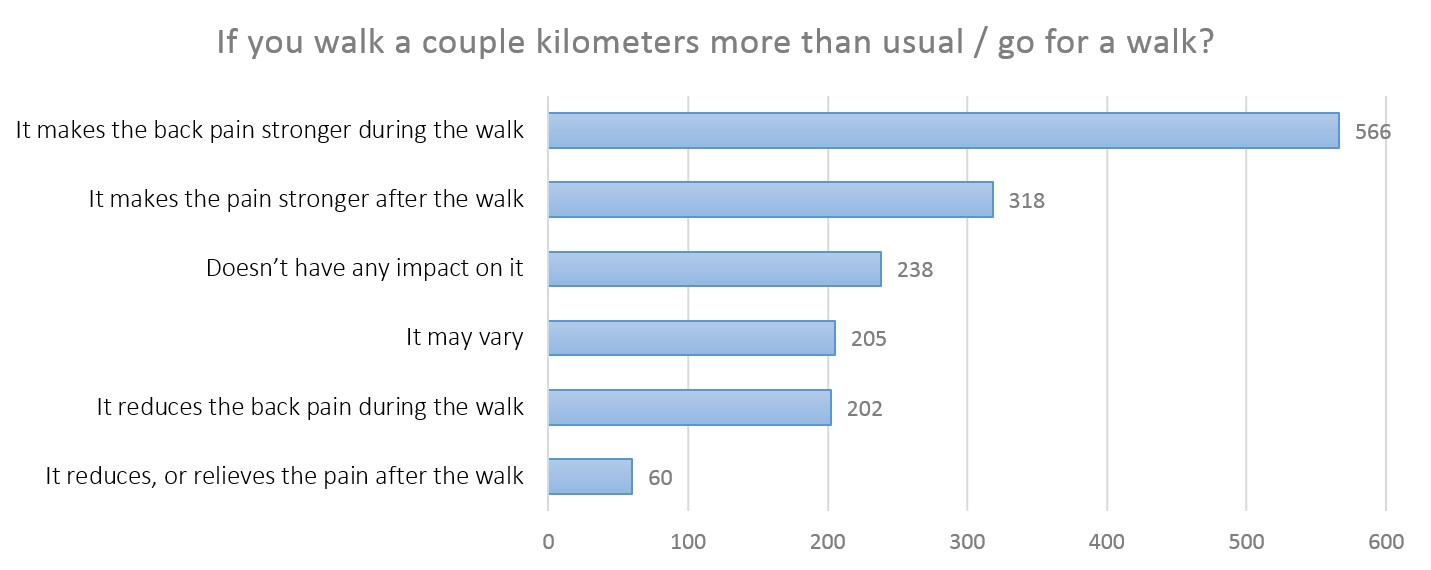Back pain during and after walking
Walks are considered excellent prophylaxis of spine problems. Doctors recommend that patients who complain of back pain should go for walks as often as possible. Nevertheless, the results of a poll we held demonstrate that walks help only a small number of people (3,2%) to get rid of pain for a long time. And only 11% of those asked can’t complain of pain while walking, but after walking the painful feelings return quickly. A part of the respondents claim that walks do not affect their sense of well-being in any way (12,8%) or have an ambiguous impact on it (11,2%). But the large majority of them confirm that back pain only becomes stronger during an uncustomary long walk or after it – 30,9% and 17,4% respectively. But why do walks that are so useful, cause the painful feelings to become stronger?

Low back pain during walking
Pain occurs most commonly in the low back – this is the region of spine, which takes on the most load when we are standing or walking. Occurrence of pain during walking is not yet a reason for panic. Everyone complains of motion discomfort from time to time. If an absolutely healthy person sits still for a long time without standing up, he will develop a backache. The cause of temporary discomfort may also lie in strenuous physical activity or an earlier disease. You tackled your morning exercises too actively, lifted a heavy bag, or decided to go back to the good old days and kick a football – this all leads to microtraumas of muscles and ligaments. In this case the prescription “Take a nap, and you’ll get well” is the most effective one. When you have slight traumas, rest is the best doctor.
Sportsmen can complain of pain during walking too. If you go in for sports, attend workouts and don’t avoid the gym, painful feelings are a signal that you need to strengthen your abdominal muscles. If the stomach muscles are weak, the low back takes on double load, which always causes pain.
It’s a different matter if pain during walking is a common occurrence. In this case it acts as a symptom of disorders of various degrees of severity, which aren’t always spinal diseases. You will not be able to determine what the matter is on your own, you need assistance of professionals. So, if you complain of back pain during walking, the cause of it can be:
- A kidney disease.
- Dystrophic changes in the vertebral gristles (osteochondrosis).
- Radiculitis.
- Lumbar hernia.
- Myositis.
Pain can be of various character: gnawing, stabbing, shooting. If you develop lumbago in your back, this is the most alarming sign. The only thing that can help in this situation is rest. If you lie down the pain will gradually cease. If you know firsthand the shooting back pain, the only thing you can do is avoid exercise load and consult a doctor for him to determine the cause of your problem and prescribe a treatment.
If you have a slight gnawing pain, you also should go through diagnostics, but in this case swimming and therapeutic exercises with emphasis on flexibility won't do you any harm. Moderate physical loads will help you strengthen the muscles of your back and to maintain the correct position of your spine. If you don’t experience back pain only while walking but also while standing, there is a big risk that you will be diagnosed with quite an unpleasant disorder, spinal stenosis. When you have stenosis, the pain goes away as soon as you sit down. In order to determine if there are any reasons for worrying, you should visit a neurologist and go through computed tomography or magnetic resonance imaging. This will give you an opportunity to find out changes in the spinal structure.
Low back pain after walking
Low back pain after walking is a much more alarming symptom than complaints of motion discomfort. In most cases it shows that there is spondylolisthesis. This medical term means instability of the spine when one of the discs protrudes backward or forward in reference to its “neighbors”. If the back pain occurs only after a long walk, the disease hasn’t yet acquired a grave character. By a long walk we mean a distance over 3 km. But if the very thought of having a little stroll causes disgust, and a distance of one kilometer seems the limit of your capabilities, the spondylolisthesis has already passed into a nasty form and requires urgent treatment. In some particularly neglected cases the instability of the spine may turn into complete inability to move your legs. In order to check if protrusion of a spinal bone is really the case, pay attention to your sensations when descending or ascending a staircase. If the pain becomes worse, consult a doctor as soon as possible.
When walks can help
Indeed, walking can help you get rid of pains, but only in that case if there are no severe diseases or they are remitting. If you admit such a fault as sedentary lifestyle, walks will help you avoid numerous spine problems. But you have to walk in a correct way. What does this mean?
The duration of a “curative” walk depends on your fitness level. It can last for 20 minutes or several hours. It’s important that you enjoy moving.
- Wear only comfortable clothes and footwear.
- Don’t take heavy bags and folders with you as any weight is bad for the spine.
- Walk at a speed that is comfortable for you, but keep a cracking pace. You shouldn’t be out of breath, but your pace should remain vigorous.
- Gather in your stomach when walking, straighten and relax your shoulders. A humped rigorous back is the key factor that causes pain in the spine.
- Try walking every day or every other day.
- It would be a good idea to combine walks with therapeutic exercises or a short warm-up.
Walking improves blood circulation and makes the spinal muscles stronger. The muscular corset plays a very important role as the muscles hold the spinal discs in the correct position. And if they are too weak to cope with this task, problems are inevitable. Pay attention to the way you sit. A slight stoop, or a habit of leaning forward too much, can cause back pain, which goes away after walking.
Понравилась статья? Поделись с друзьями!
Также стоит почитать:
Загрузка...



































 Важно знать:
Важно знать: Полезно:
Полезно: Интересно:
Интересно:




